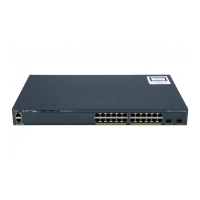18-16
Catalyst 2960 and 2960-S Switches Software Configuration Guide, Release 15.0(1)SE
OL-26520-01
Chapter 18 Configuring Optional Spanning-Tree Features
Configuring Optional Spanning-Tree Features
Beginning in privileged EXEC mode, follow these steps to enable UplinkFast and CSUF. This procedure
is optional.
When UplinkFast is enabled, the switch priority of all VLANs is set to 49152. If you change the path
cost to a value less than 3000 and you enable UplinkFast or UplinkFast is already enabled, the path cost
of all interfaces and VLAN trunks is increased by 3000 (if you change the path cost to 3000 or above,
the path cost is not altered). The changes to the switch priority and the path cost reduce the chance that
a switch will become the root switch.
When UplinkFast is disabled, the switch priorities of all VLANs and path costs of all interfaces are set
to default values if you did not modify them from their defaults.
To return the update packet rate to the default setting, use the no spanning-tree uplinkfast
max-update-rate global configuration command. To disable UplinkFast, use the no spanning-tree
uplinkfast command.
Enabling Cross-Stack UplinkFast
When you enable or disable the UplinkFast feature by using the spanning-tree uplinkfast global
configuration command, CSUF is automatically globally enabled or disabled on nonstack port
interfaces.
For more information, see the “Enabling UplinkFast for Use with Redundant Links” section on
page 18-15.
To disable UplinkFast on the switch and all its VLANs, use the no spanning-tree uplinkfast global
configuration command.
Command Purpose
Step 1
configure terminal Enter global configuration mode.
Step 2
spanning-tree uplinkfast [max-update-rate
pkts-per-second]
Enable UplinkFast.
(Optional) For pkts-per-second, the range is 0 to 32000 packets per
second; the default is 150.
If you set the rate to 0, station-learning frames are not generated,
and the spanning-tree topology converges more slowly after a loss
of connectivity.
When you enter this command, CSUF also is enabled on all
nonstack port interfaces.
Step 3
end Return to privileged EXEC mode.
Step 4
show spanning-tree summary Verify your entries.
Step 5
copy running-config startup-config (Optional) Save your entries in the configuration file.

